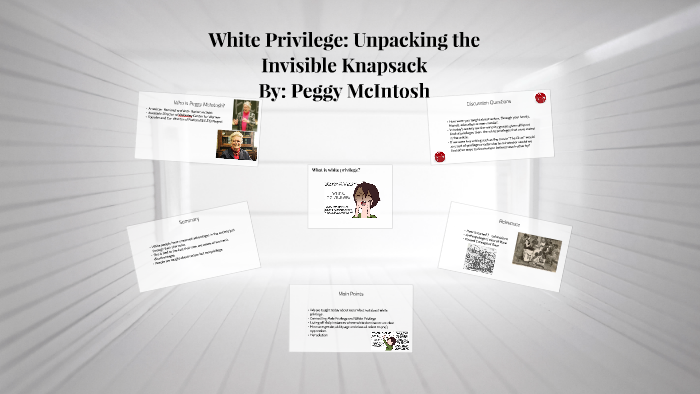
The leader uses a timer to ensure equitable sharing.

Sessions usually begin with an explanation that the individual testimonies will be uninterrupted. Topics vary greatly but often focus on matters of identity and bias for example, participants may be asked to describe experiences of having unearned advantage or disadvantage with regard to class, ethnicity, religion, gender or race.
#Unpacking the invisible backpack serial
The gift of Serial Testimony, says McIntosh, is that it privileges the living knowledge of every person in the room. “They speak from experience-not from opinion-and hearing each other, they also learn more about themselves.” “In Serial Testimony, participants, whether they are adults or schoolchildren, speak in turn around a circle or around a classroom for a limited time without referring to what others have said,” McIntosh says. During this time she developed a pedagogical approach called Serial Testimony, a facilitation method that asks participants to respond briefly to a question or prompt by drawing on their life experiences. She began building reflection, storytelling and personal history into her work with adults as well as children, first at the Rocky Mountain Women’s Institute, which she cofounded, and then at the Center for Research on Women at Wellesley College (now the Wellesley Centers for Women). Over time, McIntosh realized that her classroom innovations were directly linked to the process of revisiting her own story as a white woman in the academic world. … I began to teach in such a way that all the children were included, I expanded my curricular choices … I began to think about teaching teachers.” “When I first saw white privilege as a system of unearned advantage … that completely transformed my teaching and my sense of who counts. She had her students teach entire classes on topics they selected themselves. She stopped favoring those who always raised their hands. McIntosh underwent a period of self-reflection that led her to change her teaching.

“I realized that this whole system of education had put me in a position of trying to climb up to the so-called top lest I fall toward the ‘bottom’… I was taught to look down on almost everybody.” “I began to see systems at work-in the society and in my own previous education-that prevented me from thinking about most of the world,” says McIntosh. But despite all her accomplishments, McIntosh-a career educator-says her definition of success changed radically later in life when she began to see the education system through lenses of color and gender privilege. By all conventional measures, Peggy McIntosh was a model of success long before she wrote “The Invisible Knapsack.” From her early school days she moved easily in academic circles, eventually earning multiple degrees from elite institutions.


 0 kommentar(er)
0 kommentar(er)
